Selecting the right wheelchair
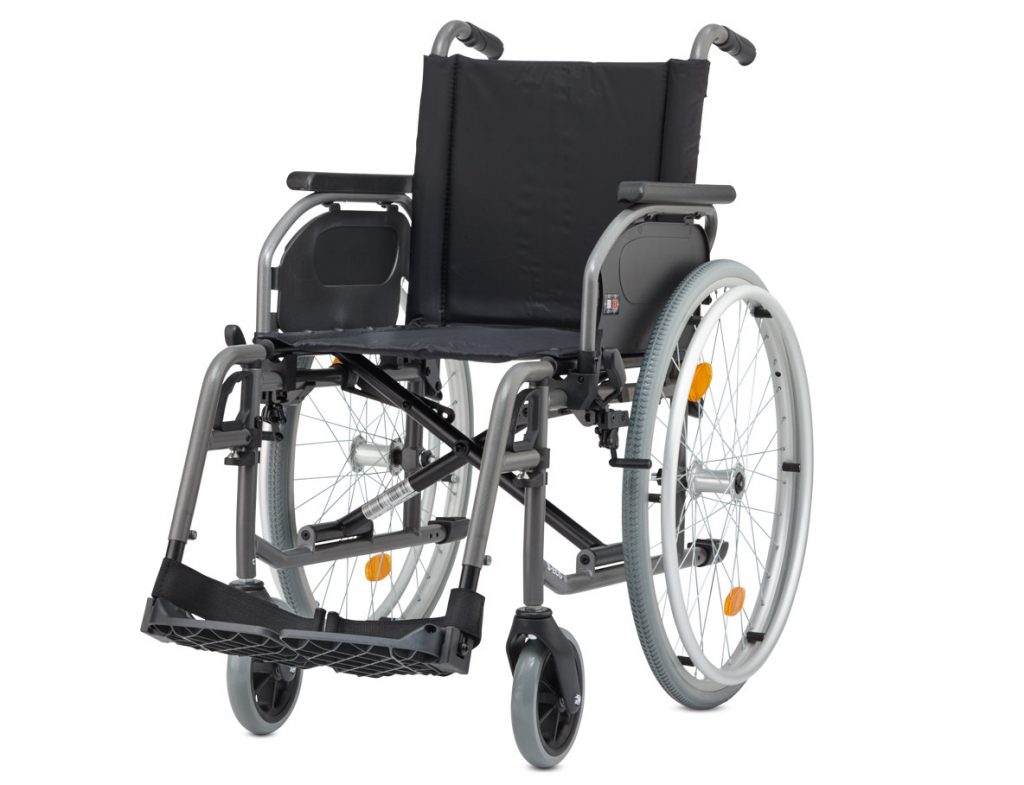
Standard- | Lightweight wheelchair
For short trips
The standard wheelchair is not intended for long periods of use. It is, basically, a temporary solution, or often used for short-term transport within hospitals or airports, for example. The sturdy construction means that these wheelchairs are relatively difficult to move. The lightweight wheelchair is a variant of the standard wheelchair. Usually it is made of tubular steel or aluminium, making it easier to handle and manoeuvre compared to the standard wheelchair. Lightweight wheelchairs are often folding wheelchairs and are therefore suitable for home use or car trips, where you can easily stow them when not in use.
Therapeutic | Multifunctional wheelchair
For use in the care sector
In contrast to the standard wheelchair, the multifunctional wheelchair offers a variety of equipment variants. Thus enabling the user to recline or helping them to sit up. These wheelchairs also adapt perfectly to the shape of the body, which makes sitting more comfortable. Multifunctional wheelchairs are often called care wheelchairs because they are ideal for the care of the elderly or people with special care needs. In general, these wheelchairs are not very manoeuvrable and can hardly be moved by the user themselves.
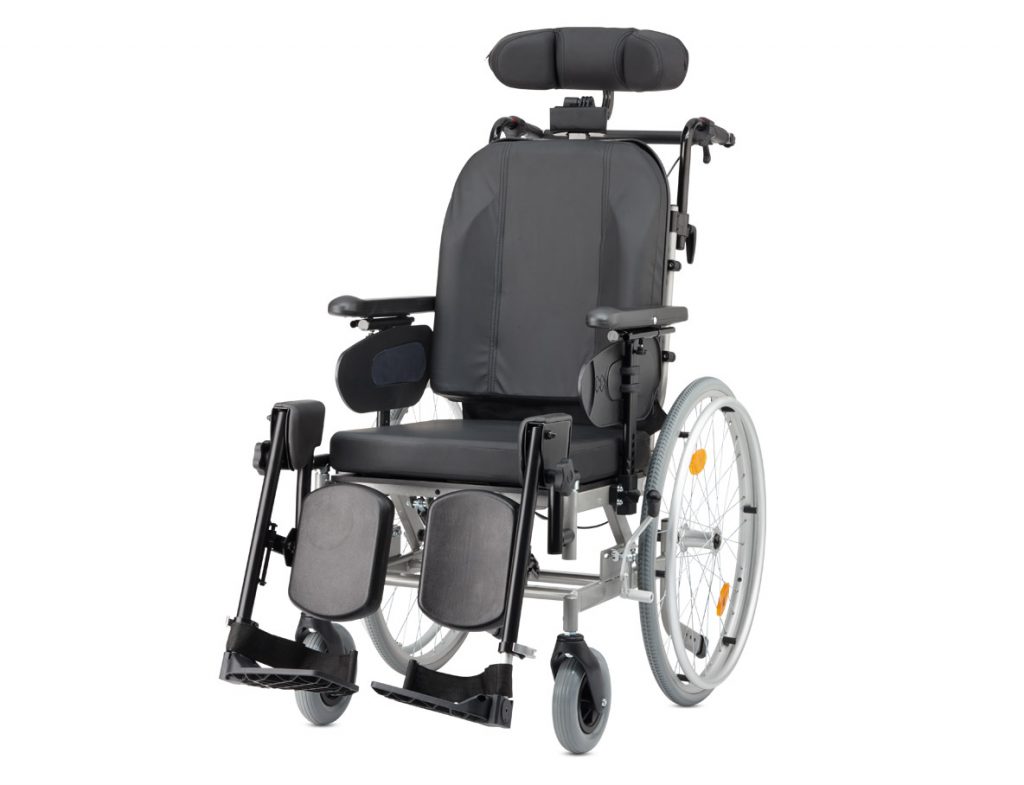
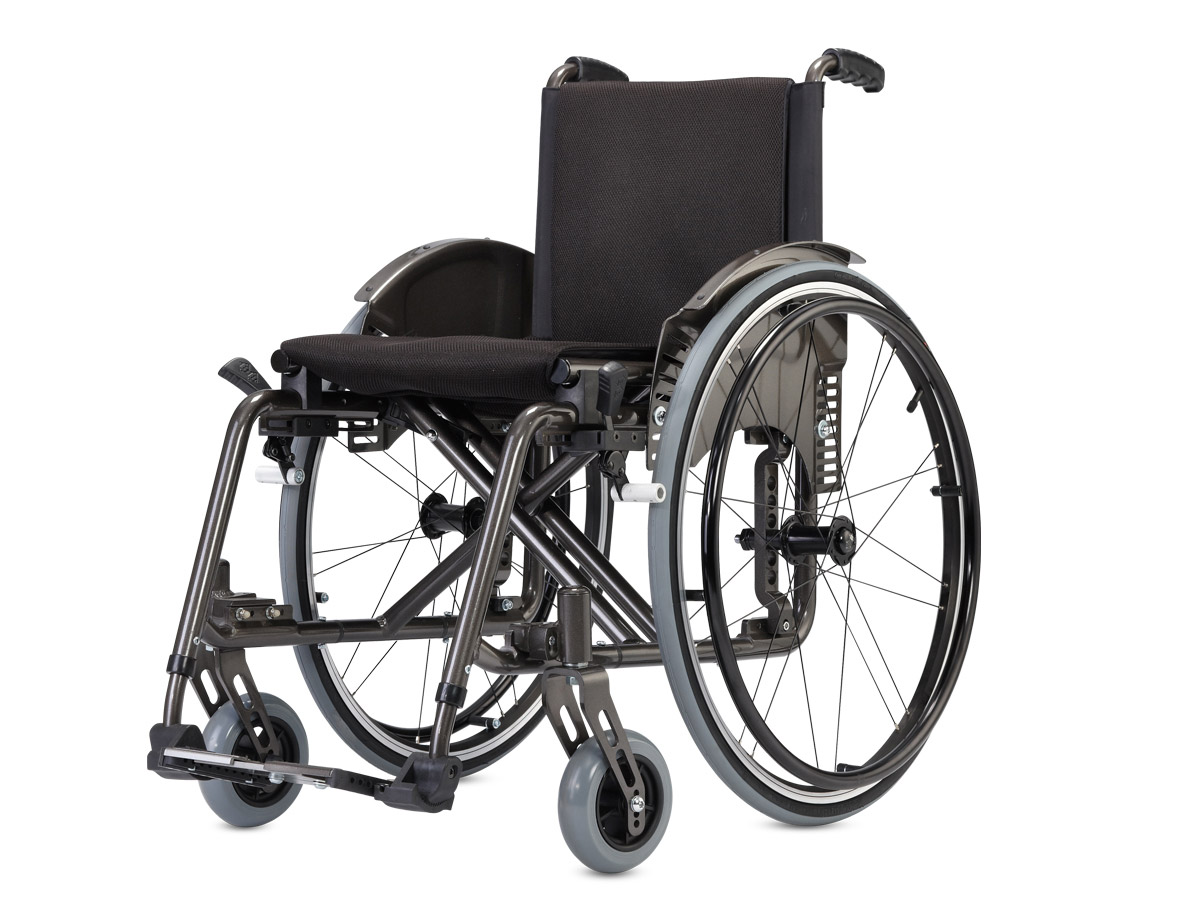
Activ- | Adaptive wheelchair
Individually adaptable for maximum activity
The active wheelchair – as its name implies – allows the user to be more active and participate in more challenging activities. As the active wheelchair is adapted to its driver by individually adjustable components, it is also known as the adaptive wheelchair. Active wheelchairs are designed for long-term use and to provide maximum mobility and independence, thereby increasing quality of life. Sports and children‘s wheelchairs also belong in the active wheelchair category.
Power wheelchair
For a high degree of mobility and independence
Electric powered wheelchairs are designed especially for people who no longer have much strength in their arms or the mobility in their hands and arms is impaired. They enable agile mobility, even in small spaces, and allow the user to cover longer distances with ease. They also offer plenty of comfort. There is a distinction between electric wheelchairs for indoor and outdoor use. Electric wheelchairs for indoor use are designed to be compact, making them highly manoeuvrable. The relatively small wheels make it possible to turn even in the tightest of spaces. Electric wheelchairs for outdoor use and scooters have larger drive wheels and a good suspension.

All a question of adjustment
Determining wheelchair dimensions correctly
An individually adapted wheelchair is the prerequisite for an optimal sitting position and maximum comfort. Experienced users who want more active locomotion have different needs and configurations to people who are just starting to use a wheelchair. All these criteria are taken into account by an experienced specialist in the medical supply store. The wheelchair is manufactured according to predetermined parameters, or adjusted to a range of specific measurements. In order to adjust the wheelchair optimally, it is helpful to do the measuring on the selected model. If this is not possible, it is advisable to have the measurements taken while sitting in a similar model.
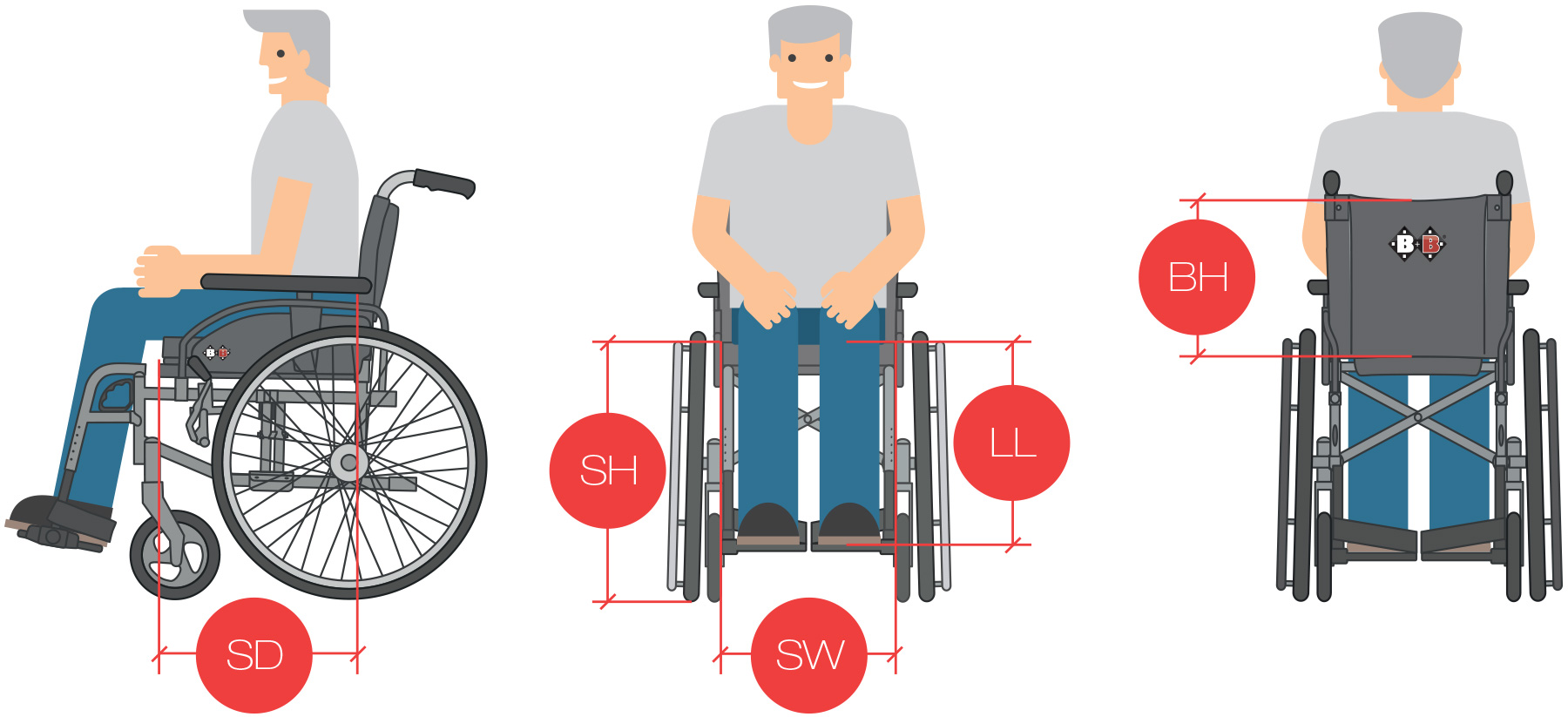
Seat depth (SD)
Seat depth is of great importance to ensure the ideal posture, an even distribution of pressure and stable leg positioning. The measurement is made from the front edge of the back tube to the front edge of the seat upholstery. Too short a seat leads to an increased load on the lower legs and thighs. Too long a seat means an awkward sitting position as the user automatically slides forward. Between the front edge of the seat upholstery and the bend in the knees there should be about two to three fingers of space. The wheelchair user is measured from the back of the hips to the back of the knees, minus the two to three fingers.
Seat height (SH)
There is a difference between front and rear seat height. The two parameters significantly influence the posture and allow optimal driving of the wheelchair. The rear seat height determines how deep you sit between the drive wheels. That has an impact on access to the handrims. The front seat height determines the seat angle. An optimal seat height is achieved when there is at least three centimetres of space under the footboard and, when the arms are hanging down, the palms are slightly above the wheel hub. On the wheelchair you measure the front seat height at the front upper edge of the seat tube, the rear seat height at the rear upper edge of the seat tube. For this parameter the wheelchair user’s lower leg length is measured, plus the required ground clearance for the footrests (+7 cm).
Seat width (SW)
For the seat width you measure the distance between the wheelchair sides. On the subject, the widest part of the pelvis when seated is measured. The rule of thumb is: width of bottom + 4 cm (2 cm on either side). Between the hip and side panel there should be at the very most space for the width of a flat hand. Because, whether you are at home or out and about, the narrower a wheelchair is, the easier it is to negotiate small spaces.
Backrest height (BH)
The height of the backrest depends on the individual disability. The wheelchair is measured from the top of the seat tube to the top of the back strap. If you want to propel yourself in the wheelchair, the backrest should end about a finger width (1-2 cm) below the shoulder blades. This leaves enough space for the shoulder blades, making it easier for the user to operate the handrims. For people with low musculature, however, a higher backrest is essential. Be sure to consider the thickness of the desired seat cushion when taking these measurements.
Lower leg length (LL)
The lower leg length determines the position of the footboard, which should be a minimum of three centimetres above the ground. The knees are bent at a 90° angle, the feet are stable on the footboard. On the wheelchair user, the measurement is taken from the back of the knee to the bottom of the sole of the foot, including the shoe. On the wheelchair, one measures from the upper edge of the seat to the upper edge of the foot plates or footrest. Don’t forget to factor in the seat cushion!
Correctly fitted
How the wheelchair is perfectly adapted to the user
For people who sit in a wheelchair most of the day, the most important thing is that they sit comfortably – and sit so that their bone structure, ligaments,
muscles and organs are not burdened. At the same time, posture has a significant influence on one’s appearance. Therefore, how a person is positioned in a wheelchair has an influence on his or her quality of life. In this way good posture helps to avoid pain and increases self-esteem. However, the optimum seating position varies from user to user and depends on their type of physical disability. The seating position has a great influence on posture. For manually driven wheelchairs it is recommended to sit relatively far back so that the user can reach the handrims easily.

Seat angle (SA)
The seat angle can be customised according to the individual requirements of the user. Ideally, the front of the seat should be higher than the back. This makes operating the handrims easiest and most effective.
Seat cushion (SC)
A seat cushion can be selected as an additional option. It can improve pressure distribution and thus give relief (anti decubitus). Additionally, poor posture can be corrected and air circulation around the wheelchair user can be improved.
Back height | Back angle (RA)
The seat unit is the basis for a healthy sitting posture. The optimum balance between support and pressure distribution allows the wheelchair user to sit for hours and supports them in their activities.
Seat unit (SU)
The seat unit is the basis for a healthy sitting posture. The optimum balance between support and pressure distribution allows the wheelchair user to sit for hours and supports them in their activities.
Camber (C)
A wheelchair with camber is easier to move and more agile. The inwardly inclined drive wheels also increase the stability. As a rule, sports and children’s wheelchairs always have camber.
E-Mobility
An electric wheelchair is suitable for people who, due to their disability or constitution, are unable to propel a manual wheelchair themselves. Electric wheelchairs and electric scooters enable their users to find new mobility, flexibility and independence – be it for their daily shopping or a drive in the country. As with manual wheelchairs, there are electric wheelchairs that are designed for indoor or outdoor use and models that are suitable for both.
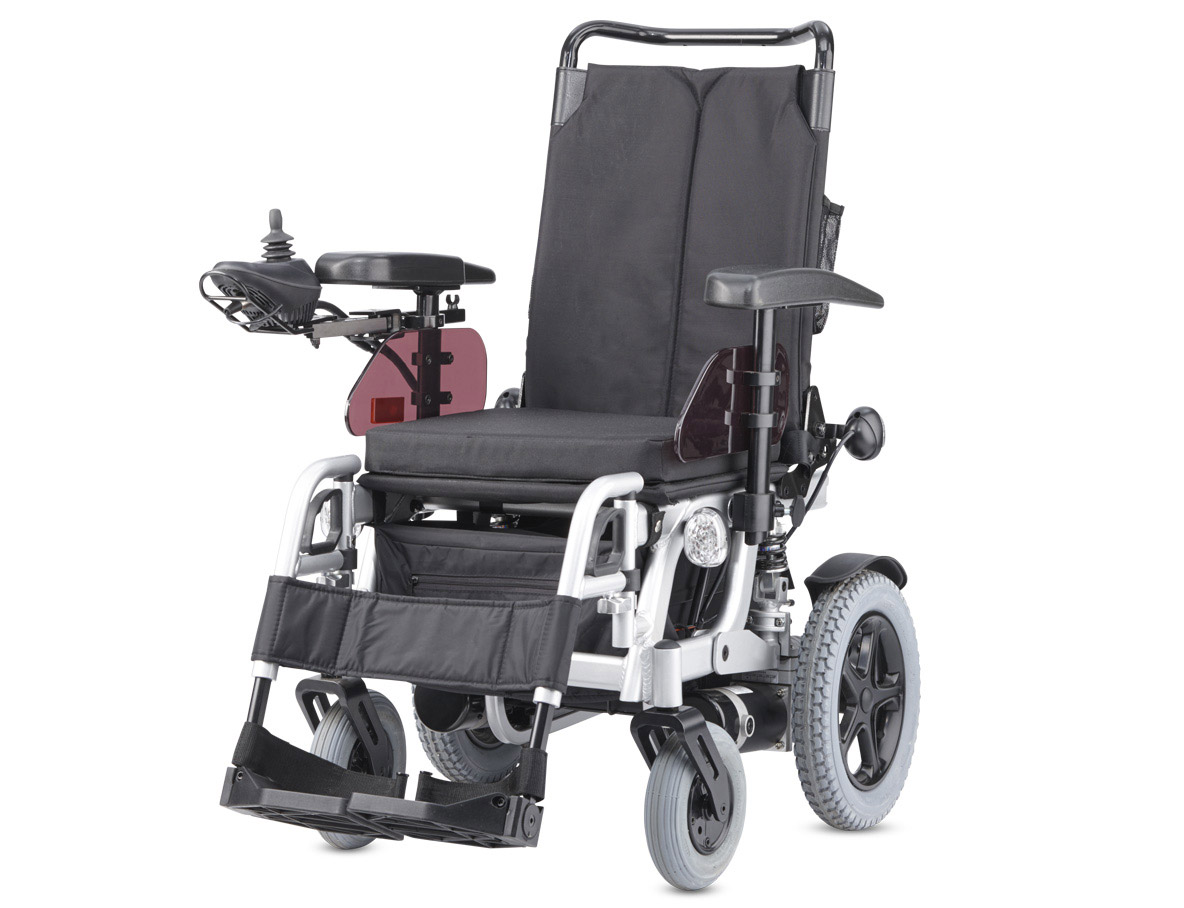
Electric wheelchairs | Indoor
Electric wheelchairs for indoor use are highly agile. They are propelled by a joystick and allow the user maximum mobility within their own home. Due to their heavy weight, these wheelchairs are not suitable for pushing. If your physical condition allows it, you can also consider a manual wheelchair with an additional motor. This chair can then be pushed by another person.
Electric wheelchairs | Outdoor
Electric wheelchairs for outdoor use have a sprung suspension, making them suitable for driving over uneven surfaces. Curbs and other obstacles and gradients can be overcome safely and effortlessly. Models that are designed exclusively for outdoor use have a longer range than hybrid models, which are equally suitable for indoor and outdoor use.

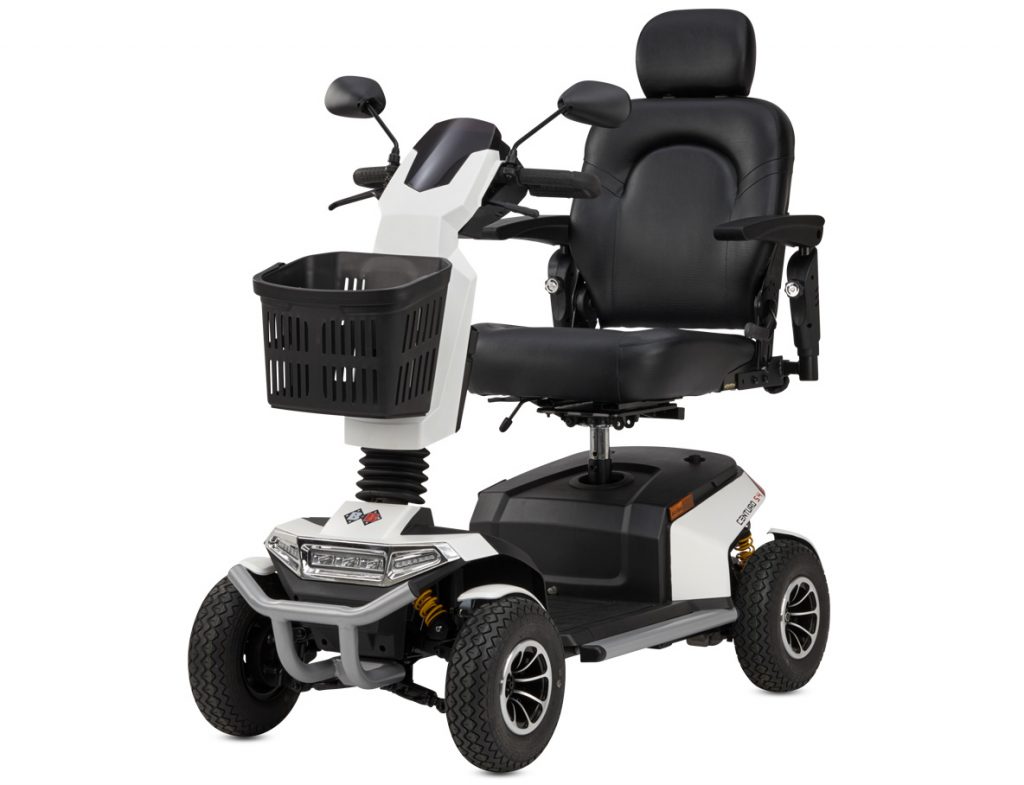
Electrical vehicles (Scooter)
Electric vehicles, also called scooters, are a special type of power wheelchairs for outdoor use. Driven by a fuel-efficient electric motor, they are virtually noiseless, environmentally friendly and without exhaust fumes. Manual control is via a handlebar and requires good upper body stability. There are electric vehicles with three or four wheels. The four-wheeled models have a higher tipping stability, which is not insignificant at speeds of up to 15 km / h. Due to their performance, electric vehicles are also suitable for longer journeys. They can be conveniently transported in a car as these vehicles can be folded and disassembled easily without tools.
